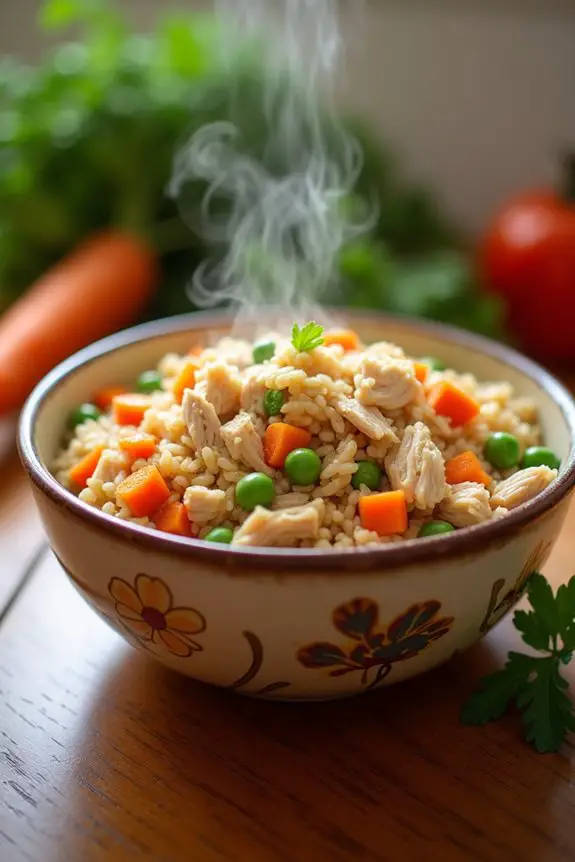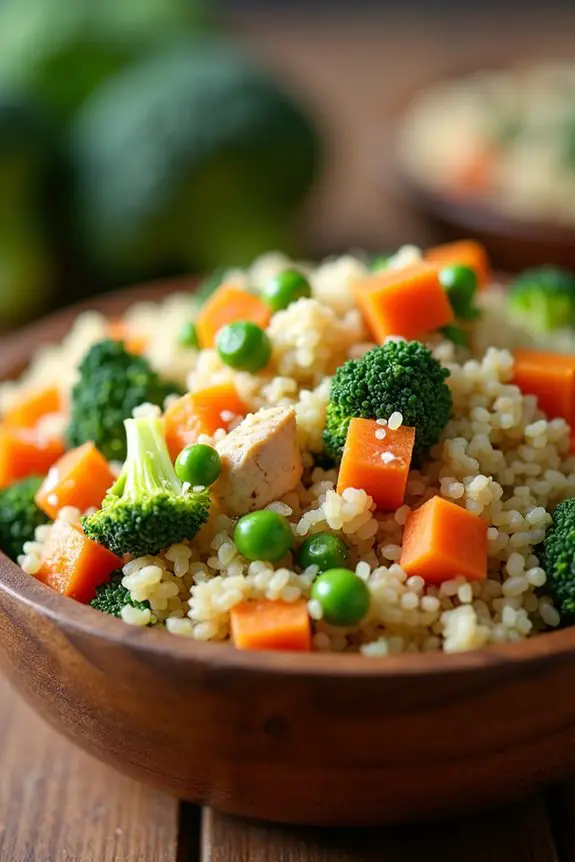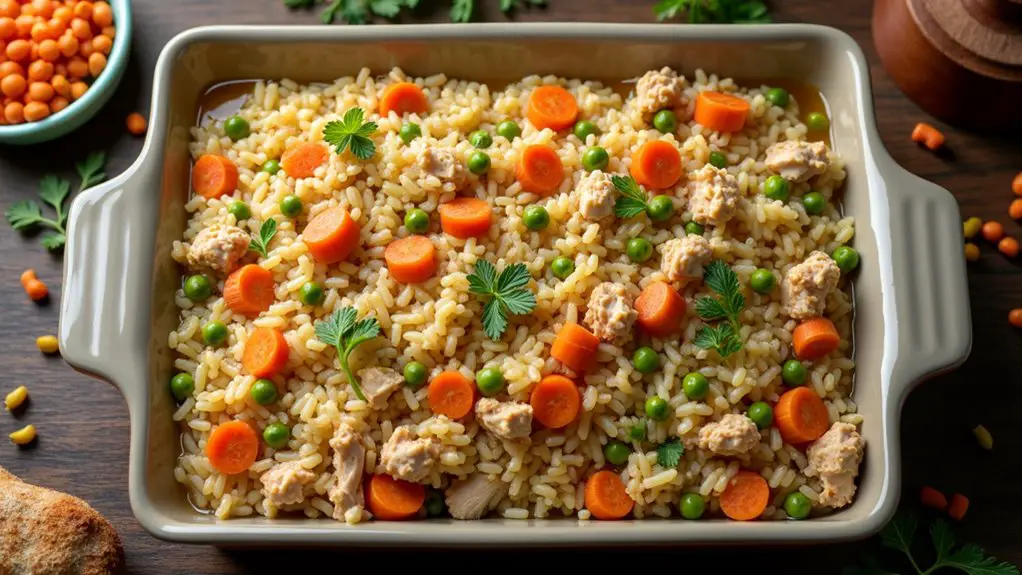If you’ve ever stood in the pet food aisle, overwhelmed by all those shiny bags, you might’ve wondered if there’s a simpler way to feed your dog. Homemade chicken and rice recipes are a fantastic solution. Not only can they be healthy and easy to whip up, but they also let you know exactly what’s going into your pup’s bowl. Ever tried cooking for your dog? You might be surprised at how much fun it can be. Stick around, and let’s explore some delicious options.
Why Homemade?
Why go homemade when it comes to dog food? Well, think about it—your furry friend deserves the best, right? With chicken and rice dog food recipes, you can whip up a nutritious meal quickly. You know what’s in it, so you won’t have to worry about mysterious ingredients or preservatives that sound like they belong in a science lab.
Homemade dog food is the best way to ensure your pup gets nutritious meals, free from mystery ingredients.
You can control the quality, which is a big deal for picky pups or those with food sensitivities.
Plus, cooking for your dog can be a real bonding experience. Imagine your pup’s tail wagging like crazy as they see you measuring out chicken and rice. And let’s be honest, it’s way more rewarding than just pouring kibble from a bag.
You’ll be a kitchen superhero, and your dog? They’ll think you’re a culinary genius. Trust me, they’ll appreciate it, and so will your heart when you see them happy and healthy.
Delicious Canine Meal Options
You want your furry friend to enjoy mealtime just as much as you do, right?
From the bright crunch of carrots mixed with chicken to the hearty blend of beef and sweet potatoes, there are so many tasty options to whip up.
Let’s chat about some drool-worthy recipes that’ll have your pup wagging their tail and begging for more.
1. Chicken and Carrot Combination

Ready to whip up something tasty for your pooch? Combining chicken and carrots not only makes for a colorful bowl but also packs in nutrition. Let’s go through the essential ingredients, step-by-step instructions, and even some fun optional add-ons that’ll have your furry friend wagging their tail in no time. Additionally, choosing a premium puppy food can ensure that your pet receives the right balance of nutrients essential for their growth and development. It’s important to note that premium dog food is specifically formulated to meet the unique dietary needs of breeds like the Shih Tzu.
Ingredients
When it comes to whipping up a delicious meal for your furry friend, simplicity is the name of the game! This chicken and carrot concoction isn’t only tasty for pups but is also super easy to make. The best part? You probably have most of these ingredients in your kitchen already.
So, let’s dive right in, shall we?
- 2 cups of cooked, shredded chicken (chicken breast works great!)
- 1 cup of carrots, chopped (fresh or frozen, both are fine)
- 1 cup of brown rice (it’s healthy and fills them up)
- ½ cup of peas (frozen ones work seamlessly, no need to cook)
- ¼ cup of chicken broth (low sodium is best, flavor without the saltiness)
- 1 tablespoon of olive oil (a little something to keep their coat shiny)
And there you have it! With just a handful of simple ingredients, you’ll have a homemade dog meal that your canine companion will gobble up like it’s their last meal.
Because let’s face it, dogs definitely know when they’re being treated to something special.
Step by Step Instructions
Start by prepping your cooking space and ingredients. This meal will have your pup wagging their tail in excitement, so let’s get going!
- Gather your ingredients: boneless, skinless chicken breasts, carrots, brown rice, and some low-sodium chicken broth (or water if you’re feeling adventurous).
- Preheat your stovetop to medium heat. We want to give that chicken a nice cooking sizzle.
- Chop the carrots into small pieces, about the size of your pinky nail. If you accidentally cut them into tiny bits, don’t worry. Just add an extra pinch of love.
- Place your cubed chicken in a frying pan. Add a splash of low-sodium chicken broth (or water). Cook for about 5–7 minutes, stirring occasionally until the chicken is no longer pink and is cooked through.
- Stir in your chopped carrots once the chicken is cooked. Let them dance together for another 5 minutes. Watch for the carrots to soften a bit—it’s like they’re auditioning to be the star of the dish.
- Meanwhile, rinse your brown rice under cold water in a fine mesh strainer. It’s like giving it a little spa treatment.
- In a separate pot, bring 2 cups of water or low-sodium chicken broth to a boil. Stir in the rice, cover, and reduce the heat to low. Let it simmer for about 40–45 minutes—check occasionally, but don’t get too cozy; a watched pot never cooks.
- Once the rice is fluffy and tender, gently fold it into the chicken and carrot mixture. Mix well until everything is combined and looks like a tasty feast.
- Let the mixture cool down for about 10 minutes, giving you just enough time to brag to your pup about how you’re a master chef.
Optional Add-ons
Now that you’ve whipped up a scrumptious chicken and carrot combo, you might be wondering how to spice things up a bit.
Consider tossing in some peas or even a sprinkle of parsley for that extra flair. Your pup will adore the color and flavors, and honestly, who wouldn’t want to eat a meal that looks this good?
Keep it fun and tasty!
2. Beef and Sweet Potato Mix

Ready to whip up a tasty Beef and Sweet Potato Mix for your furry friend? You’ll love how simple the ingredients are, and I promise your pup will be wagging their tail in no time. In addition to this delicious recipe, consider incorporating luxury dog food for an even more delightful dining experience. Let’s go through the step-by-step instructions together, and I’ll share some optional add-ons that can make this meal extra special! Additionally, using premium dog food can ensure your Goldendoodle maintains a healthy diet.
Ingredients
Making a homemade beef and sweet potato dog food mix isn’t only a delicious option for your pup, but it’s also super easy to throw together. Just gather a few wholesome ingredients, and you’ll be well on your way to whipping up a nutritious meal. Here’s what you’ll need:
- 1 pound of ground beef (lean is best, because who wants to deal with the greasy aftermath?)
- 2 medium sweet potatoes, peeled and diced (sweet potatoes are like nature’s candy for dogs)
- 1 cup of green beans, chopped (fresh or frozen work just fine)
- 1/2 cup of carrots, chopped (the crunchier, the better)
- 1/4 cup of peas (frozen is totally acceptable, just make sure they aren’t seasoned)
- 4 cups of water (to bring it all together—just like a good friend)
Now, wasn’t that easy?
Just picture your dog watching you with those pleading eyes, as if saying, “Are you really going to make that bland kibble again?”
Your furry friend deserves a little variety, don’t you think?
Step by Step Instructions
- Start by gathering all your ingredients: ground beef, sweet potatoes, carrots, peas, and any dog-safe seasonings you plan to use. It’s like lining up your little helpers for a cozy kitchen adventure.
- Preheat your oven to 350°F (175°C). This is where the magic begins, so don’t forget to turn on the heat!
- Peel and dice the sweet potatoes into small cubes—about half an inch is perfect. We want them to cook evenly, and no one likes a mouthful of gigantic veggies.
- In a large pot, bring water to a boil. Add the diced sweet potatoes and let them cook for about 15-20 minutes, or until fork-tender. You know you’re there when you can easily poke them with a fork.
- While the sweet potatoes are boiling, heat a large skillet over medium heat. Add the ground beef and cook until browned, stirring occasionally. Aim for about 5–7 minutes, and don’t forget to break it up into smaller pieces.
- Once the beef is cooked, drain any excess fat (because we like to keep things healthy for our furry friends).
- Now, let’s add some color. Toss in the diced carrots and peas to the skillet with the beef. Cook for an additional 3-4 minutes until the veggies are tender—such a cheerful mix, right?
- Drain the sweet potatoes and return them to the pot. Mash them up using a fork or potato masher until smooth. This is the time for a tiny bit of dog-friendly broth or water if you want a creamier texture.
- Fold the beef and veggie mixture into the mashed sweet potatoes, making sure everything is well combined. It should be a beautiful sight—like a colorful confetti party in your bowl.
- Transfer your delicious mixture into a baking dish. Spread it evenly and smooth out the top, just like frosting a cake (but for a dog—don’t eat it).
- Bake in the oven for about 25–30 minutes, until it’s heated through and starts to look a little golden on top. Your home will smell amazing, and you might even find yourself slightly envious.
- Cool completely before serving to your dog. Remember, patience is a virtue, especially when it comes to giving your pup a tasty meal that’s just right.
Optional Add-ons
When you’re looking to spice up your dog’s mealtime, think about adding a few tasty extras to that beef and sweet potato mix.
Maybe toss in some green beans for crunch or a dash of turmeric for health. You can even sneak in bits of cooked chicken.
Your pup might just do a happy dance. Who knew mealtime could be so fun?
3. Savory Chicken and Peas Mix

If you’re looking for a tasty treat for your pup, the Savory Chicken and Peas Mix is the way to go. It packs simple, wholesome ingredients that are easy to whip up, perfect for even the most inexperienced cook. So, what do you need? Let’s break it down with step-by-step instructions and a few optional add-ons to make it extra special. Additionally, your furry friend will enjoy this meal alongside some fun with an automatic dog ball thrower, making mealtime exciting and engaging!
Ingredients
When it comes to whipping up a tasty meal for your pup, nothing beats the classic combo of chicken and peas.
It’s not just a meal; it’s a feast! Imagine your furry friend wiggling with excitement, just waiting to dig in.
And the best part? You can whip this up with stuff you probably already have at home.
Step by Step Instructions
Ready to whip up a tasty treat for your pup? This savory chicken and peas mix isn’t just easy but made with love. Follow these clear steps and soon your dog will be enjoying a delightful meal that’s both nutritious and delicious.
- Start by boiling 2 cups of water in a pot. (You know, that classic bubbling sound—like the song of dinner time.)
- Once the water is boiling, stir in 1 cup of rice. Cover the pot, reduce the heat to low, and let it simmer for 20 minutes. (Your kitchen will smell heavenly, trust me!)
- While the rice is cooking, chop 1 pound of chicken breast into small, bite-sized pieces. (Keep an eye on those fingers—chicken can be slippery.)
- In a frying pan, heat 1 tablespoon of olive oil over medium heat. Add the chicken pieces and cook for about 5-7 minutes, stirring occasionally until they’re golden brown and no longer pink inside. (If your chicken starts to dance, it’s probably ready!)
- Sprinkle in a pinch of salt and stir to season the chicken, then toss in 1 cup of frozen peas. Cook for an additional 3-4 minutes until the peas warm up. (You’ll know they’re ready when they turn a vibrant green.)
- Once the rice is finished, use a fork to fluff it up. Then, fold it gently into the chicken and peas mixture. (Think of it like a cozy blanket wrapping around your pup’s favorite toys.)
- Remove the skillet from the heat and let everything cool down for a few minutes.
- Finally, scoop out portions and serve! Cool completely before serving to your dog. (Trust me, you don’t want a singed pup after they’ve been keenly waiting for this.)
And there you go—your dog will thank you with tail wags and maybe a happy bark!
Optional Add-ons
Though your savory chicken and peas mix is already a fantastic meal for your furry friend, you might be wondering how to jazz it up a bit.
Consider adding some carrots for crunch or a sprinkle of kibble for texture. Maybe toss in a bit of pumpkin for fiber.
Your pup will thank you with wagging tails and puppy eyes, but just don’t forget the treats.
4. Chicken and Rice Delight

When it comes to whipping up a Chicken and Rice Delight for your pup, you’re in for a treat. You’ll want to grab a few simple ingredients and follow some straightforward steps—don’t worry, it’s easier than you think, even if your kitchen skills are more “hot dog and beans” than gourmet chef. Ready to turn your kitchen into a canine dining experience?
Ingredients
When it comes to whipping up a tasty meal for your furry friend, chicken and rice is like the ultimate comfort food! It’s easy to make, packed with nutrients, and I bet your dog will gobble it up in seconds.
Plus, you probably have most of these ingredients lurking around in your kitchen. So, let’s get down to the nitty-gritty. Here’s what you’ll need to make this scrumptious canine delight.
- 2 cups of boneless, skinless chicken breast, diced
- 1 cup of brown rice (just like the healthy version we love)
- 1 carrot, finely chopped (for a little crunch and sweetness)
- 1/2 cup of peas (fresh or frozen, your pick)
- 4 cups of low-sodium chicken broth or water
- 1 tablespoon of olive oil (a little healthy fat goes a long way)
Just imagine the wagging tails and happy barks as you serve this meal up!
Now, how awesome does that sound? Happy cooking, and may your pup enjoy every single bite.
Step by Step Instructions
To whip up a delicious chicken and rice meal for your furry friend, let’s plunge into some easy-to-follow steps.
You’ll be amazed at how simple it’s to create a wholesome dish that will have tails wagging in no time—who knew cooking for a dog could bring such joy?
- Start by gathering all your ingredients: 1 cup of brown rice, 2 cups of water, 1 pound of boneless, skinless chicken breasts, 1 cup of diced carrots, and 1 cup of peas. (Those are the basics; feel free to toss in any other dog-friendly veggies if you’re feeling adventurous.)
- Rinse the brown rice in a fine mesh strainer under cold water until the water runs clear. (Trust me, this helps with texture; nobody wants gummy rice!)
- In a medium pot, combine the rinsed rice and 2 cups of water. Bring it to a boil over medium-high heat.
- Once boiling, reduce the heat to low, cover the pot, and let it simmer for about 20 minutes or until the rice has absorbed the water and is fluffy. (Keep an eye on it; you want perfectly cooked rice, not a rice brick.)
- Meanwhile, in a separate large pan, place the chicken breasts and add enough water to cover them. Bring it to a boil over medium-high heat. (This can feel like watching paint dry, but it’s worth the wait!)
- Once the chicken reaches a rolling boil, reduce the heat and let it simmer for 12–15 minutes, until fully cooked and no longer pink in the middle. (You’re not just trying to impress your pup here; you want to avoid any potential doggy tummy troubles.)
- Remove the chicken from the pan and let it cool slightly, then shred it into bite-sized pieces using two forks. (Shredding is a workout; who knew cooking could double as exercise?)
- In the same pan with chicken broth, add the diced carrots and peas. Cook on medium heat for about 5 minutes, until they’re tender and the carrots are bright in color. (This is where the meal starts to get colorful and appetizing!)
- Stir the shredded chicken and cooked rice into the pan with the veggies. Mix all the ingredients together well until fully combined. (Feel free to show off your mixing skills—everyone loves a good stir.)
- Cool completely before serving to your dog. (Trust me, you don’t want to burn those precious pup tongues.)
Enjoy watching your furry friend’s joy as they dig into this homemade meal. Happy cooking!
Optional Add-ons
You might be surprised at how easy it’s to jazz up your chicken and rice dog food with some tasty optional add-ons.
Try stirring in steamed veggies like carrots or green beans—they’re nutritious and colorful. A spoonful of pumpkin can work wonders for digestion.
You could even sprinkle in some cheese if your pup loves that cheesy goodness. Your dog will thank you.
5. Nutritious Turkey and Quinoa Bowl

Ready to whip up a tasty Turkey and Quinoa Bowl for your pup? You’ll love how simple it’s with just a few wholesome ingredients, plus we’ve got step-by-step instructions to make it a breeze. And hey, if you’re feeling adventurous, I’ll throw in some optional add-ons to spice things up—because who doesn’t love a little variety, right?
Ingredients
Creating a hearty meal for your pup can be a real joy. With the right ingredients, you can whip up something both tasty and healthy. This turkey and quinoa bowl is just the ticket. Packed with protein and essential nutrients, it’s bound to have your furry friend wagging their tail in delight. Let’s explore what you’ll need for this delicious dish.
- 1 cup ground turkey
- 1/2 cup quinoa, rinsed
- 1 cup spinach, chopped
- 1/4 cup carrots, finely diced
- 1/2 cup water or low-sodium chicken broth
- 1 tablespoon olive oil (for healthy fats)
- A pinch of parsley (optional for flavor)
Now, just imagine how excited your pup is going to be when that wonderful aroma fills the kitchen. And trust me, it feels good knowing you’re serving up something nutritious. So, roll up those sleeves and let’s make mealtime extra special.
Step by Step Instructions
- Gather all your ingredients: ground turkey, quinoa, carrots, spinach, and peas. Trust me, this bowl is about to become a doggie favorite.
- Rinse 1 cup of quinoa under cold water to remove any bitterness. Yes, it’s like giving the quinoa a revitalizing shower.
- In a medium saucepan, add the rinsed quinoa and 2 cups of water. Stir it a bit, then bring to a boil. When it starts bubbling away, reduce the heat to low, cover, and let it simmer for about 15 minutes or until all the water is absorbed.
- While that’s cooking, grab a large skillet and heat it over medium heat. Toss in 1 pound of ground turkey and cook it, breaking it apart with a spatula, until it’s nice and browned—about 5–7 minutes. No pink in sight, please.
- Add 1 cup of diced carrots and sauté them with the turkey for another 5 minutes. You’re looking for those carrots to soften and make friends with the turkey.
- Stir in 1 cup of spinach and 1 cup of peas. Cook for 2–3 minutes, just until the spinach wilts and those peas are heated through. A pop of color never hurt, right?
- Once the quinoa is done, fluff it with a fork (like you just won the fluffing Olympics), and then mix it into the turkey-veggie mixture.
- Combine everything well, ensuring all ingredients are evenly distributed.
- Serve your pup with generous portions.
- Cool completely before serving to your dog. Patience is a virtue, especially when it comes to not burning little tongues.
Optional Add-ons
While your pup might be head over heels for that turkey and quinoa bowl, there’s no harm in jazzing things up now and then, right?
Toss in some carrots or peas for a crunch that’ll have their tail wagging. Maybe sprinkle a bit of pumpkin puree for fiber.
Who doesn’t love a fancy dinner? Your furry friend will think they’re dining like royalty.
6. Cheesy Chicken and Broccoli Mix

Ready to whip up a scrumptious meal for your pup? The Cheesy Chicken and Broccoli Mix isn’t just tasty, it’s packed with nutrients your furry friend will love. So, let’s go over the ingredients, step-by-step instructions, and some fun optional add-ons to take this dish to the next level.
Ingredients
Making a tasty meal for your furry friend can be such a rewarding experience, and this Cheesy Chicken and Broccoli Mix is no exception.
The cheese gives it a little oomph, while the broccoli adds some crunch. It’s like a cozy dinner for your pup, and trust me, they’ll wag their tail with excitement.
Let’s get to those ingredients so you can start cooking up some love for your four-legged buddy!
- 2 cups cooked, shredded chicken
- 1 cup steamed broccoli florets
- 1/2 cup cooked brown rice
- 1/4 cup low-fat cheddar cheese, shredded
- 1/4 cup chicken broth (low-sodium, please)
- 1/4 cup carrots, finely chopped
Now, gather these simple ingredients, and you’re almost halfway to creating a drool-worthy meal.
Just imagine your dog’s face when you serve this up. It’s going to be priceless!
Step by Step Instructions
- Gather all your ingredients: chicken, rice, broccoli, and cheese. Don’t forget to wash your hands — we want everything squeaky clean.
- Preheat your oven to 350°F (175°C). Give it a moment to cozy up; we want a warm space for our doggy masterpiece.
- In a large pot, boil about 2 cups of water. Once boiling, add 1 cup of rice. Stir it gently and reduce the heat to low. Cover and cook for about 18-20 minutes until fully absorbed.
- While the rice is cooking, dice 1 pound of chicken into small, bite-sized pieces. Bigger isn’t better when it comes to doggie portions.
- In a skillet over medium heat, add a splash of olive oil. Toss in the diced chicken and cook until it’s no longer pink, about 5-7 minutes. The chicken should look golden brown in places — yum!
- In the same skillet, add 2 cups of chopped broccoli. Stir it in with the chicken, then cover for about 5 minutes. The broccoli should be bright green and tender, but still crisp — we don’t want mushy veggies here.
- As everything is cooking, grate about 1 cup of cheese. Cheddar or mozzarella works well. Let’s be honest, who can resist cheese?
- Once the rice is ready, fluff it with a fork. Combine the rice, chicken, broccoli, and half of the cheese in a large mixing bowl. Mix everything together until it’s well combined.
- Transfer the mixture into a greased baking dish. Spread it out evenly. Top with the remaining cheese, because cheese brings happiness, right?
- Bake in the preheated oven for about 25-30 minutes until the cheese is bubbly and lightly browned. Your kitchen will smell heavenly — your dog may even know something delicious is happening.
- Once baked, remove the dish from the oven and let it cool completely before serving it to your dog. They might have some impressive puppy eyes that say “Hurry up,” but we should play it safe with the temperature.
There you have it—a cheesy chicken and broccoli mix that’s sure to tail-wag! Enjoy those wagging tails, because that’s the best kind of reward.
Optional Add-ons
While your dog is likely thrilled with the cheesy chicken and broccoli mix, why not take it up a notch?
Toss in some cooked carrots or peas for extra crunch and vitamins. Maybe sprinkle a little shredded cheese on top, if you’re feeling generous. Your pup will be barking with joy.
Plus, it’s an easy way to keep their meals exciting.
7. Chicken and Rice Casserole

Ready to whip up a Chicken and Rice Casserole that’ll have your dog wagging its tail in delight? You’ll need some simple ingredients, a few easy steps, and maybe even a sprinkle of creativity with optional add-ons. Let’s get cooking and turn your kitchen into a pup-approved dining spot!
Ingredients
When it comes to making a wholesome meal for your furry friend, chicken and rice is the ultimate go-to—simple, nutritious, and oh-so-delicious. This recipe is like a warm hug in a bowl for your pup, and it’s super easy to whip up. So, let’s gather our ingredients, shall we? Here’s what you’ll need to create a scrumptious Chicken and Rice Casserole that your dog will drool over.
- 2 cups cooked, shredded chicken (use that leftover rotisserie chicken, if you have it)
- 1 cup brown rice (easy on the tummy)
- 1 cup carrots, diced (they’ll love that crunch)
- 1 cup peas, frozen or fresh (healthy and oh-so-pretty)
- 1 tablespoon olive oil (for that extra shine)
- 2 cups low-sodium chicken broth (just enough to moisten, but not drown)
Step by Step Instructions
- Preheat your oven to 350°F (175°C) to get it nice and warm for your casserole.
- Boil about 2 cups of water in a medium pot over high heat. Add 1 cup of rice once boiling. Cover and lower the heat to simmer for 15–20 minutes, until the water is absorbed and the rice is tender.
- While the rice is cooking, chop 2 cups of cooked chicken into small, bite-sized pieces. It doesn’t need to be perfect—just make sure they’re not huge chunks!
- In another large mixing bowl, combine the cooked rice and chopped chicken. Stir it well until everything is mixed together nicely.
- Now, add 1 cup of frozen peas and carrots to the mixture. Fold them in gently to avoid mashing the veggies (we want them intact, right?).
- Pour in 1 cup of low-sodium chicken broth to keep things moist. Give it another good stir; everything should be coated evenly.
- Transfer the chicken and rice mixture into a greased 9×13 inch baking dish, spreading it out evenly. This will help it bake evenly too.
- Bake in the preheated oven for 25–30 minutes, or until the edges start bubbling and everything looks heated through.
- Once done, take it out and allow it to cool for a few minutes. Trust me, you don’t want to serve it too hot!
- Cool completely before serving to your dog. They’ll appreciate it, and you’ll avoid any singed puppy tongues!
Optional Add-ons
Once your chicken and rice casserole is out of the oven and cooling, you might be wondering how to make it even better for your furry friend.
Consider adding some steamed veggies like carrots or peas—just a few, since dogs can be picky. You could even sprinkle in a little parsley for extra flavor.
Trust me, your pup will appreciate the upgrade.
Proper Food Storage Techniques
Storing your homemade chicken and rice dog food might seem straightforward, but failing to do it right could mean sad, spoiled meals for your furry friend. You wouldn’t want to serve something stinky on their dinner plate, right?
First, let it cool completely before transferring it to airtight containers. Those cute little containers are your best friends. If you can’t eat it in a few days, freeze it! Portion it out into meal-sized servings—trust me, scooping frozen blocks isn’t fun when your dog’s staring at you, tail wagging.
Let it cool completely, then store in airtight containers. Freeze extras in meal-sized portions for easy access later!
Label each container with the date, too. You’ll thank yourself later. If you’re anything like me, I forget what day it is.
When it’s dinner time, just thaw overnight in the fridge or pop it in the microwave—and remember to stir! You don’t want any hot spots. Your pup deserves the best food, free from fridge funk. Keeping it fresh keeps them happy!
Frequently Asked Questions
Can I Use Brown Rice Instead of White Rice?
Yes, you can use brown rice instead of white rice. Brown rice provides more fiber and nutrients, making it a healthier option for your pup. Just guarantee it’s cooked properly for easy digestion.
How Long Can I Store Homemade Dog Food?
You can store homemade dog food in the fridge for up to three days. If you freeze it, it’ll stay good for about two to three months. Just remember to thaw it completely before serving!
Is This Recipe Suitable for All Dog Breeds?
Yes, this recipe’s suitable for most dog breeds. However, always check with your vet if your pup has specific dietary needs or allergies, ensuring their meal aligns with their health requirements and preferences.
Can I Add Vegetables to Chicken and Rice Recipes?
Yes, you can absolutely add vegetables to chicken and rice recipes! Incorporating dog-safe veggies like carrots, peas, or green beans can enhance nutrition and flavor, making mealtime even more enjoyable for your pup. Just avoid any toxic options!
How Do I Transition My Dog to Homemade Food?
You can shift your dog to homemade food gradually. Start by mixing a small amount with their current food, increasing the homemade portion over time. Monitor for any digestive issues, adjusting as needed. Patience helps!

Hi, I’m Ali Tarek, the founder of Animalsman. I’ve always been passionate about pets, especially dogs and cats, and I created this website to share practical tips, easy recipes, and helpful care advice for fellow pet lovers. My goal is to make pet care simple, enjoyable, and accessible for everyone. When I’m not writing or curating content, you’ll usually find me spending time with my furry friends or learning new ways to keep them happy and healthy.



